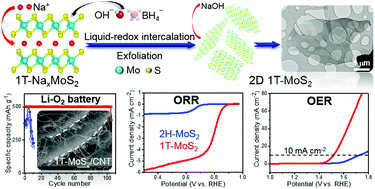Our official English website, www.x-mol.net, welcomes your
feedback! (Note: you will need to create a separate account there.)
Metallic MoS2 nanosheets: multifunctional electrocatalyst for the ORR, OER and Li–O2 batteries†
Nanoscale ( IF 5.8 ) Pub Date : 2018-11-15 00:00:00 , DOI: 10.1039/c8nr07106c Zoya Sadighi 1, 2, 3 , Jiapeng Liu 1, 2, 3 , Ling Zhao 1, 2, 3 , Francesco Ciucci 1, 2, 2, 3, 4 , Jang-Kyo Kim 1, 2, 3
Nanoscale ( IF 5.8 ) Pub Date : 2018-11-15 00:00:00 , DOI: 10.1039/c8nr07106c Zoya Sadighi 1, 2, 3 , Jiapeng Liu 1, 2, 3 , Ling Zhao 1, 2, 3 , Francesco Ciucci 1, 2, 2, 3, 4 , Jang-Kyo Kim 1, 2, 3
Affiliation

|
Lithium–oxygen batteries (LOBs) possess the highest theoretical specific density among all types of lithium batteries, making them ideal candidates to replace the current Li ion batteries for next-generation electric vehicle applications. However, designing highly active catalysts with high electronic conductivities to kinetically accelerate the sluggish oxygen reduction/evolution reactions (ORR/OER) is still a big challenge. This work was dedicated to developing two-dimensional (2D) trigonal phase MoS2 (1T-MoS2) nanosheets as a highly active electrocatalyst for LOBs for the first time. Metallic 1T-MoS2 prepared via in situ liquid-redox intercalation and exfoliation was hybridized with functionalized carbon nanotubes (CNTs) to form freestanding, binder-free oxygen electrodes. The 1T-MoS2/CNT electrode exhibited excellent electrochemical performances with a high reversible capacity of 500 mA h g−1 at a current density of 200 mA g−1 for more than 100 cycles owing to the catalytically active surfaces of 1T-MoS2 accessible by Li+ ions and O2. Density functional theory (DFT) calculations identified the catalytically active basal planes in 1T-MoS2 during the ORR as well as the initial ORR path during LOB cycles. The results based on the rotational ring disk electrode (RRDE) experiments also supported the findings from the DFT calculations, where the 1T-MoS2 basal planes are active for both the ORR and OER, not the semiconducting hexagonal MoS2 (2H-MoS2) whose edges are only electrocatalytically active. This study sheds light on the use of metallic 1T-MoS2 as a multifunctional oxygen electrocatalyst for LOB applications with enhanced ORR and OER activities.
中文翻译:

金属MoS 2纳米片:用于ORR,OER和Li–O 2电池的多功能电催化剂†
锂氧电池(LOB)在所有类型的锂电池中具有最高的理论比密度,使其成为替代当前用于下一代电动汽车应用的锂离子电池的理想选择。然而,设计具有高电子电导率的高活性催化剂以动力学上促进缓慢的氧还原/放出反应(ORR / OER)仍然是一个巨大的挑战。这项工作首次致力于开发二维(2D)三角相MoS 2(1T-MoS 2)纳米片,作为LOB的高活性电催化剂。金属1T-MOS 2制备通过原位液态氧化还原层插层和剥落层与功能化的碳纳米管(CNT)混合形成独立的,无粘结剂的氧电极。的1T-MOS 2 / CNT电极显示出与500毫安Hg的高可逆容量优异的电化学性能-1处的200毫安g的电流密度-1超过100个循环,由于的催化活性表面的1T-MOS 2访问由Li +离子和O 2引起。密度泛函理论(DFT)计算确定了1T-MoS 2中的催化活性基面在ORR中以及在LOB周期中的初始ORR路径中。基于旋转环盘电极(RRDE)实验的结果也支持DFT计算的结果,其中1T-MoS 2基面对ORR和OER均有效,而不对半导电六角形MoS 2(2H-MoS 2),其边缘仅具有电催化活性。这项研究揭示了将金属1T-MoS 2用作具有增强的ORR和OER活性的LOB应用的多功能氧电催化剂。
更新日期:2018-11-15
中文翻译:

金属MoS 2纳米片:用于ORR,OER和Li–O 2电池的多功能电催化剂†
锂氧电池(LOB)在所有类型的锂电池中具有最高的理论比密度,使其成为替代当前用于下一代电动汽车应用的锂离子电池的理想选择。然而,设计具有高电子电导率的高活性催化剂以动力学上促进缓慢的氧还原/放出反应(ORR / OER)仍然是一个巨大的挑战。这项工作首次致力于开发二维(2D)三角相MoS 2(1T-MoS 2)纳米片,作为LOB的高活性电催化剂。金属1T-MOS 2制备通过原位液态氧化还原层插层和剥落层与功能化的碳纳米管(CNT)混合形成独立的,无粘结剂的氧电极。的1T-MOS 2 / CNT电极显示出与500毫安Hg的高可逆容量优异的电化学性能-1处的200毫安g的电流密度-1超过100个循环,由于的催化活性表面的1T-MOS 2访问由Li +离子和O 2引起。密度泛函理论(DFT)计算确定了1T-MoS 2中的催化活性基面在ORR中以及在LOB周期中的初始ORR路径中。基于旋转环盘电极(RRDE)实验的结果也支持DFT计算的结果,其中1T-MoS 2基面对ORR和OER均有效,而不对半导电六角形MoS 2(2H-MoS 2),其边缘仅具有电催化活性。这项研究揭示了将金属1T-MoS 2用作具有增强的ORR和OER活性的LOB应用的多功能氧电催化剂。

































 京公网安备 11010802027423号
京公网安备 11010802027423号